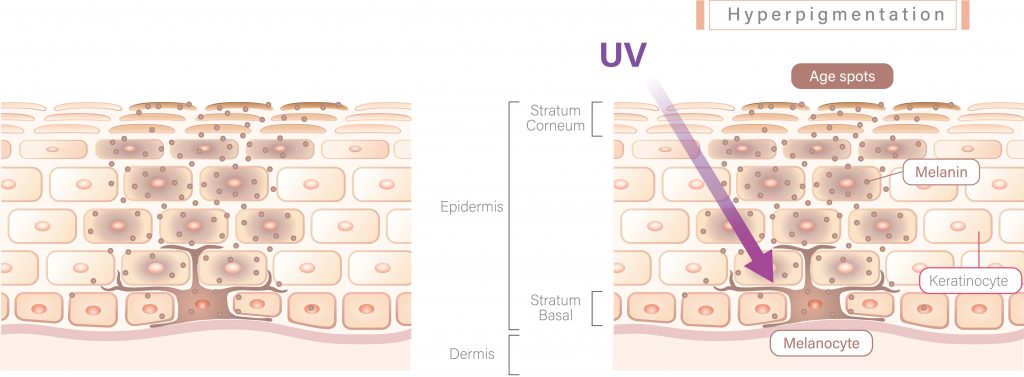
30
Mar
What Causes Hyperpigmentation

The excessive production of melanin causes hyperpigmentation. In skin cells known as melanocytes, a pigment known as melanin is generated, which is responsible for the color of the skin. Listed below are a few of the many possible contributing factors:
- Excessive exposure to the sun
- Certain chemotherapy medicines
- Pregnancy
- Lupus Erythematosus and other certain medical diseases
- Allergies
- Injuries caused by chemicals or physical force
- Inflammatory disorders
- Tobacco use is prohibited
- Obesity
- Diabetes
- Hormonal factors play a role
- Aging
- Certain ethnic groups
- Contact with cosmetic items regularly
- Exposure to a range of topical products over an extended period
- Contact with plants that contain furocoumarins
- Scratching or other minor injuries to the skin regularly
- Heat or infrared radiation exposures that are modest in intensity
Some of the medical diseases that might cause hyperpigmentation are as follows:
- The ailment is known as Addison’s illness
- Diabetic dermopathy is a skin condition caused by diabetes
- Acanthosis nigricans is a type of fungus
- Hyperthyroidism
- Hemochromatosis is a condition that runs in families
- Inflammatory pigmentation following chikungunya illness
- Lichen planus pigmentosus is a type of lichen
- Actinic lichen planus is a type of lichen
WHAT IS HYPERPIGMENTATION, AND HOW DOES IT OCCUR?
Darkening of the skin that is more noticeable than the surrounding areas:
- Appear in tiny clusters or areas
- Cover a broad area
- Have an impact on the entire body
Although hyperpigmentation is not harmful, it may indicate another medical disease.
Additionally, hyperpigmentation can manifest itself in a variety of ways. The most frequently encountered are as follows:
- Melasma is a skin pigmentation that often affects the sun-exposed parts of the face or stomach. Familiar with people with darker complexions who live in areas exposed to high ultraviolet (UV) light levels.
- Sunspots, also known as solar lentigines, are tan to dark brown spots that appear on parts exposed to the sun, such as the hands, face, forearms, upper chest, and upper back, among other places. It is most commonly caused by prolonged exposure to the sun.
- Post-inflammatory hyperpigmentation is a kind of hyperpigmentation that occurs following an injury or inflammation of the skin. Acne is the most prevalent reason for this sort of rash to appear.

Ways To Treat Hyperpigmentation
However, hyperpigmentation is a condition that can be identified and treated in various ways.
A dermatologist can assist you in determining the reason for your hyperpigmentation. They will take a medical history and perform a physical examination to ascertain the cause. Moreover, a skin biopsy may help narrow down the defense in some circumstances.
Prescription Medication
Furthermore, you can treat certain types of hyperpigmentation can with topical prescription medicine. Typically, this prescription contains hydroquinone, a bleaching agent.
However, chronic use of topical hydroquinone (without interruptions) might result in skin darkening, called ochronosis. Therefore, it is better to use topical hydroquinone under the supervision of a dermatologist who can instruct you on how to use the medication safely and effectively.
Additionally, topical retinoids aid in lightening dark patches on the skin.
However, these drugs take several months to work their way through dark areas.
At-Home Therapy
Occasionally, at-home therapy may involve over-the-counter drugs that might help lighten dark patches. These over-the-counter drugs contain less hydroquinone than prescription medications.
Include sunscreen in in-home care. Sunscreen is the single most essential component in resolving most hyperpigmentation-related conditions. Keep an eye out for:
- a sunscreen that is physically inhibiting, ideally with zinc oxide as the primary active ingredient
- a minimum of SPF 30 to 50
- a broad coverage spectrum also
Furthermore, dermatologists recommend using sunscreen daily. Reapply it every two hours if you are in direct sunlight – more frequently, you’re sweating or swimming.
Additionally, there are skin conditions in which visible light may contribute to the perpetuation of hyperpigmentation, such as melasma.
For instance, seek out a mineral sunscreen that contains iron oxide, which can block some visible light. Daily use. Furthermore, wear sun-protective clothes fortified with SPF.
Additionally, online shopping for apparel is fortified with SPF.
Depending on the causes of your hyperpigmentation, your doctor may also recommend laser treatment or chemical peels to help minimize it.
